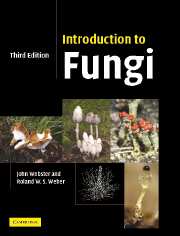Book contents
- Frontmatter
- Contents
- Preface to the first edition
- Preface to the second edition
- Preface to the third edition
- Acknowledgements
- 1 Introduction
- 2 Protozoa: Myxomycota (slime moulds)
- 3 Protozoa: Plasmodiophoromycota
- 4 Straminipila: minor fungal phyla
- 5 Straminipila: Oomycota
- 6 Chytridiomycota
- 7 Zygomycota
- 8 Ascomycota (ascomycetes)
- 9 Archiascomycetes
- 10 Hemiascomycetes
- 11 Plectomycetes
- 12 Hymenoascomycetes: Pyrenomycetes
- 13 Hymenoascomycetes: Erysiphales
- 14 Hymenoascomycetes: Pezizales (operculate discomycetes)
- 15 Hymenoascomycetes: Helotiales (inoperculate discomycetes)
- 16 Lichenized fungi (chiefly Hymenoascomycetes: Lecanorales)
- 17 Loculoascomycetes
- 18 Basidiomycota
- 19 Homobasidiomycetes
- 20 Homobasidiomycetes: gasteromycetes
- 21 Heterobasidiomycetes
- 22 Urediniomycetes: Uredinales (rust fungi)
- 23 Ustilaginomycetes: smut fungi and their allies
- 24 Basidiomycete yeasts
- 25 Anamorphic fungi (nematophagous and aquatic forms)
- References
- Index
- Plate section
15 - Hymenoascomycetes: Helotiales (inoperculate discomycetes)
- Frontmatter
- Contents
- Preface to the first edition
- Preface to the second edition
- Preface to the third edition
- Acknowledgements
- 1 Introduction
- 2 Protozoa: Myxomycota (slime moulds)
- 3 Protozoa: Plasmodiophoromycota
- 4 Straminipila: minor fungal phyla
- 5 Straminipila: Oomycota
- 6 Chytridiomycota
- 7 Zygomycota
- 8 Ascomycota (ascomycetes)
- 9 Archiascomycetes
- 10 Hemiascomycetes
- 11 Plectomycetes
- 12 Hymenoascomycetes: Pyrenomycetes
- 13 Hymenoascomycetes: Erysiphales
- 14 Hymenoascomycetes: Pezizales (operculate discomycetes)
- 15 Hymenoascomycetes: Helotiales (inoperculate discomycetes)
- 16 Lichenized fungi (chiefly Hymenoascomycetes: Lecanorales)
- 17 Loculoascomycetes
- 18 Basidiomycota
- 19 Homobasidiomycetes
- 20 Homobasidiomycetes: gasteromycetes
- 21 Heterobasidiomycetes
- 22 Urediniomycetes: Uredinales (rust fungi)
- 23 Ustilaginomycetes: smut fungi and their allies
- 24 Basidiomycete yeasts
- 25 Anamorphic fungi (nematophagous and aquatic forms)
- References
- Index
- Plate section
Summary
Introduction
In contrast to the Pezizales (see preceding chapter) which produce apothecia with asci discharging their spores through a detachable lid at their apex, the asci of inoperculate discomycetes liberate their spores either through a valve or a slit. In the inoperculate as well as operculate discomycetes, the asci may contain two or more layers, i.e. they are often described as bitunicate. However, these layers do not separate during ascus discharge, i.e. they are non-fissitunicate. Fine structural details of the asci of Helotiales have been described by Verkley (1993, 1994, 1996). Two large ecological groups of inoperculate discomycetes can be distinguished: the lichenized and non-lichenized species. This feature correlates approximately with the taxonomy at the level of orders, and here we shall discuss the Helotiales (sometimes alternatively called Leotiales) which contain mostly non-lichenized fungi. The Lecanorales and other orders with mainly or exclusively lichen-forming fungi are described in Chapter 16.
Those relatively few phylogenetic studies that have so far been performed on the Helotiales lack the necessary power of resolution to delimit natural groups. Thus, it is not clear at present whether this order is monophyletic or not, and several different classification schemes are in use (Gernandt et al., 2001; Kirk et al., 2001; Pfister & Kimbrough, 2001). The families currently associated with the Helotiales are listed in Table 15.1. Thus circumscribed, the order Helotiales contains some 2300 species. The Orbiliaceae, formerly included here (Pfister, 1997), are now considered to be more closely related to the Pezizales.
- Type
- Chapter
- Information
- Introduction to Fungi , pp. 429 - 445Publisher: Cambridge University PressPrint publication year: 2007

